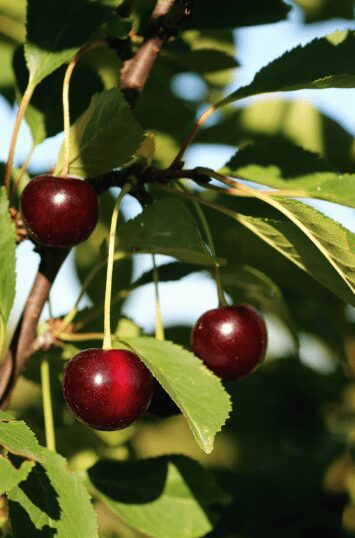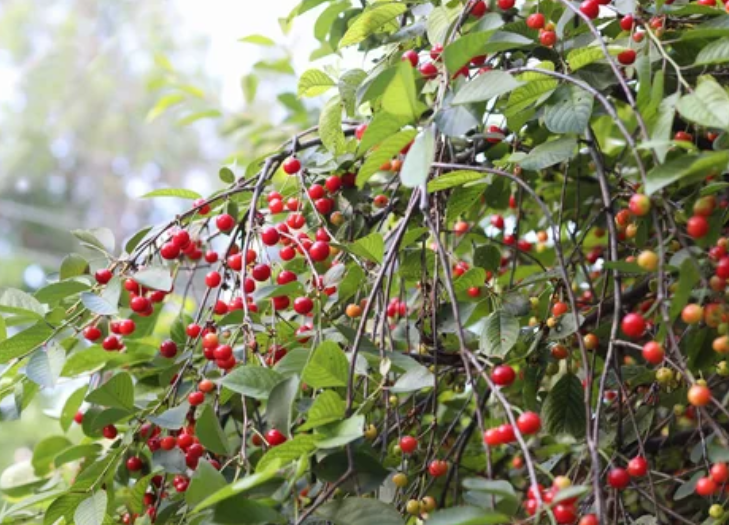What is cherry bush, and why is it good for you?
Cherry bush refers to various shrubs or small trees that produce cherries. They suit you because cherries are rich in antioxidants, vitamins, and minerals. They have numerous health benefits, including reducing inflammation, promoting better sleep, and supporting heart health.
You came to the right place if you’ve ever dreamed of having your cherry bush. We’ll tell you the secret to growing a thriving cherry bush that will have your neighbors green with envy. From choosing a suitable variety to pruning and planting techniques, we’ve got you covered. We’ll dive into the world of bush cherries and explore how they can be a game-changer for your garden.
Whether you’re interested in growing cherry bushes indoors or want to know more about the benefits of dwarf cherry bushes, we have all the information you need. We’ll also answer frequently asked questions about cherry bushes that will help you quickly become a cherry-growing expert. So get ready to dig in and discover the joy of growing your delicious cherries.
Bush Cherries – A Game-changer
Bush cherries are a game-changer for any garden or edible landscape. These hardy and versatile shrubs offer a variety of tart and sweet cherries, including popular cultivars like Cupid and Romeo. With their self-pollinating nature and adaptability to different climates, cherry bushes are a fantastic addition to any home garden. The width of cherry bushes makes them an excellent choice for filling in gaps and creating natural borders in your garden.
The University of Saskatchewan has developed hardy cherry cultivars, such as Crimson Passion and Carmine Jewel, perfect for Canada’s cooler regions. These cherries thrive in full sun and well-drained soil, ideal for various settings, from a small backyard to a large orchard.
Proper care and maintenance are crucial when growing cherry bushes. Regular watering, fertilization, and pruning ensure healthy growth and a bountiful fruit set. Harvesting cherries at the right time, typically in late summer or early fall, guarantees the perfect balance of flavor and sweetness. Don’t forget to share your success by propagating cherry bushes through cuttings or seeds and spreading the joy of fresh cherries!
Growing Cherry Bushes Indoors
Growing cherry bushes indoors allows you to enjoy the sweet taste of cherries right in the comfort of your home. By selecting a dwarf or compact variety, such as the cupid, you can quickly cultivate a cherry bush indoors without worrying about space limitations.

Place your cherry bush near a south-facing window or under grow lights to provide ample sunlight. Ensure the soil is well-draining and water the bush properly to prevent any root-related issues. Regular pruning and shaping will keep the cherry bush healthy, promote airflow, and avoid overcrowding.
Consider using a balanced fertilizer formulated explicitly for fruit-bearing plants to maximize their growth. Enjoy the delights of indoor cherry cultivation and add a touch of fresh sweetness to your home.
The Benefits of Dwarf Cherry Bushes
Dwarf cherry bushes, also known as compact cherry bushes, come with many benefits, making them an attractive choice for many gardeners. Despite their compact size, these small and hardy shrubs produce impressive cherries.
With their shorter stature, dwarf cherry bushes are easier to maintain and make harvesting a breeze. Furthermore, they exhibit increased resistance to diseases and pests, ensuring your cherry crop remains healthy and abundant.
The compact size of these bushes also allows for effortless netting, protecting your cherries from birds and other hungry critters. Whether you have a small garden, want to create an edible landscape, or prefer the versatility of a compact cherry tree, a dwarf cherry bush from reputable nurseries such as the University of Saskatchewan offers you an excellent option for fresh eating, jam-making, or even adding beauty to your yard.
Romeo Cherries: The Perfect Choice for Your Garden
Romeo cherries, a specific variety of bush cherries, are known for their exceptional taste and disease resistance. These cherries are self-pollinating, making them a convenient choice for home gardeners. With their compact size, Romeo cherries thrive in small gardens or containers, offering versatility in various settings.
Despite their diminutive stature, these trees produce abundant, bright red cherries with a sweeter flavor. Whether enjoyed fresh or used in cooking, Romeo cherries are a delightful addition to any edible landscape. Add these hardy, self-fertile cherry bushes to your garden and enjoy the benefits of fresh, homegrown cherries.
Tips for Pruning and Planting Cherry Bushes
Proper pruning and planting techniques ensure cherry bushes’ health and productivity. When pruning and planting cherry bushes, following specific guidelines is essential. One of the first steps is to select an appropriate location for planting, preferably with ample sunlight and well-drained soil.
Adequate sunlight ensures optimal growth and fruit production. Preparing the soil by removing any weeds or grass and adding compost or organic matter to provide the necessary nutrients is recommended.
During the dormant season, which typically falls between late winter and early spring, plant the cherry bushes, spacing them appropriately to allow for future growth. Pruning cherry bushes annually is also essential to promote healthy growth and remove dead or diseased branches.
Proper pruning techniques involve making clean cuts at a 45-degree angle and avoiding over-pruning, which can lead to reduced fruit production. Mulching around the base of the cherry bush provides several benefits, including moisture retention and weed suppression.
Picking and Shipping Cherries: What You Need to Know
For optimal cherry bush growth and fruit production, pruning is a must. Prune cherry bushes during the dormant season, typically in late winter or early spring. Select a location with well-drained soil and total sun exposure when planting cherry bushes. Remember to plant multiple cherry varieties or use a compatible pollinator for cross-pollination.
When it’s time to pick cherries, choose fully ripe but firm fruits, and detach them from the branch gently to avoid any harm to the tree, ensure the safe arrival of your cherries by using robust packaging and shipping materials.
Nurseries in Saskatchewan for Cherry Bushes
If you plan to add a cherry bush to your garden in Saskatchewan, you’re in luck! Several well-adapted cherry nurseries in Saskatchewan offer various cherry bushes ideally suited for the local climate. When selecting a cherry bush for your home garden, choose a sunny location with well-draining soil to ensure optimal growth.
Pruning also plays a crucial role in promoting healthy growth and abundant fruit production. Late winter or early spring is the ideal time to prune your cherry bush, removing any dead, damaged, or diseased branches and thinning out crowded branches. By visiting nurseries in Saskatchewan, you can find the perfect cherry bush for your garden and enjoy delicious cherries for years.
Frequently Asked Questions About Cherry Bushes
Pruning plays a vital role in promoting healthy growth and maximizing the fruit production of cherry bushes.
It is advisable to prune cherry bushes during the dormant season, typically in late winter or early spring.
By removing dead, damaged, or diseased branches, you can ensure adequate sunlight and air circulation for the remaining branches.
Proper planting is also essential for cherry bushes. Select a sunny location with well-drained soil to provide the ideal conditions for growth.
Additionally, plant multiple cherry varieties or a compatible pollinator nearby to facilitate cross-pollination and ensure fruitful results.
When picking and shipping cherries, handle fully ripe but firm fruits carefully to prevent any damage during transportation.
Conclusion
To grow a thriving cherry bush, it’s essential to understand the different varieties and growing conditions that suit your needs. Whether you’re looking to grow cherry bushes indoors or in your garden, there are specific tips and techniques for pruning and planting that will help you achieve success.
Additionally, we have all the information you need if you’re interested in picking and shipping cherries or finding nurseries in Saskatchewan that offer cherry bushes. Don’t miss out on our comprehensive guide to growing cherry bushes and start enjoying the fruits of your labor.
In conclusion, the Cherry Bush, predominantly consisting of Prunus cerasus (sour cherries) and Prunus avium (sweet cherries), offers excellent fruit for various culinary uses. Notably, the Valentine, Juliet, Mongolian cherry and the Montmorency are some varieties of tart cherry, each with distinct characteristics.
For instance, the Montmorency variety is known for its high sugar content, making it perfect for jams. At the same time, the Cupid cherry, alongside Valentine and Juliet, are more astringent fruit, prized for its unique flavors.
Interestingly, the Nanking cherry, a native of Western Asia, has been successfully cultivated in Europe and North America, including Alberta, where researcher Vaughn Hammond has contributed significantly to developing dwarf sour cherries.
These dwarf varieties, such as the Mongolian cherry, are ideal as hedge plants or small trees, typically growing up to 6-8 ft. They are favored for their hardiness, especially in hardiness zones with harsh winters. Like the Prunus cerasus, sour cherries tend to ripen around August, while other varieties may extend into September.
Moreover, mulch can promote soil moisture retention, which is essential for cherry bush maintenance. Additionally, given their dense foliage, cherry bushes can be a windbreak. The cultivation and enjoyment of these cherries encompass a rich tradition spanning from Western Asia to Europe and North America, with an array of flavors from the tart cherries to the sweeter counterparts that continue to delight the palate.























